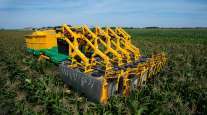Managing Editor, Features and Multimedia
Self-Driving Trucks and Presidential Politics

[Stay on top of transportation news: Get TTNews in your inbox.]
The introduction of self-driving truck prototypes over the past five years has fueled an ongoing conversation about how this emerging technology will change the freight transportation industry in the decades ahead. The prospect of automated trucking also has become part of a broader discussion about the spread of automation and the future of work. And lately, this topic has even made its way into the 2020 U.S. presidential campaign.
Entrepreneur Andrew Yang, a dark-horse candidate for the Democratic presidential nomination, has warned that automation will displace large numbers of workers and has frequently pointed to trucking as a prime example of an industry facing this type of disruption.
An open discussion about the effects of automation on our society is both welcome and necessary, but in this case, Yang has painted an unrealistically bleak portrait of trucking’s future that has become all too common among observers from outside the industry. His campaign website even cites the potential for “serious unrest” as robot vehicles eliminate truck driving jobs — the most common occupation in a majority of U.S. states.

Clevenger
But this notion that millions of Americans working in freight transportation face imminent displacement is simply not rooted in reality.
Just ask the companies that are actually developing the technology.
Truck manufacturers, their key suppliers and a growing number of technology startups are pursuing a variety of business models as they test and refine automated driving systems for commercial vehicles. Some are focusing on advanced driver-assist technology. Some are developing highly automated and in some cases fully unmanned vehicles for specific-use cases. And some are investing in both approaches simultaneously. But none are attempting to completely automate the entire freight transportation industry.
Among the developers aiming to make unmanned trucks a reality, most are working to automate only highway driving while leaving the more complex driving tasks associated with urban and regional routes to trucks piloted by drivers.
One of these companies, Ike, said its goal is to build technology that complements truck drivers rather than competing against them.
The tech startup recently teamed up with economist Charles Hodgson to build an economic model projecting how its approach to automated trucking might affect truck driving jobs.
That study, published last month on medium.com, offers a scenario based on autonomous trucks launching in Texas in 2023, then expanding across the entire interstate highway system by the end of that decade. In that hypothetical, Ike’s model suggests that the rollout of unmanned trucks on highways in hub-to-hub operations gradually could replace about 210,000 over-the-road trucking jobs by 2030, but would also create about 136,000 new shorthaul jobs as overall freight costs decline. That net job loss would be less than the 78,000 drivers Hodgson estimates will retire over the next decade.

Fourth Quarter iTECH
- A Witness in the Cab
- Some Fleets Reluctant to Add Driver-Facing Cameras
- Analysis of Onboard Video Can Yield Operational Insights
- Self-Driving Trucks and Presidential Politics
- Driver Training, Monitoring Could Help Ensure Safe Testing, Deployment of Automated Trucks
- In-Cab Monitoring Uses Machine Vision to Detect Fatigued, Distracted Driving
And even that scenario is significantly more aggressive than the timelines implied by more established players in the commercial vehicle industry.
Daimler Trucks North America, for instance, has begun on-road testing of highly automated trucks in southwest Virginia in cooperation with its Torc Robotics subsidiary, with the stated goal of introducing the technology in 10 years.
Meanwhile, Volvo Trucks’ Vera transport solution represents another way that autonomous vehicles are entering freight operations in limited deployments.
Vera uses unmanned, electric-powered tractors with no cabs or steering wheels to haul trailers or shipping containers along short, repetitive routes at relatively low speeds in industrial areas such as ports and quarries.
Again, Vera is designed to automate only specific tasks, and does so in a way that complements existing trucking operations that will continue to rely on drivers for many years to come.
There’s little doubt that automated driving technology will steadily advance and gradually scale up over time, enhancing safety and improving freight efficiency along the way. But the day when a safe, qualified, professional truck driver can no longer find a job in our industry is still merely conjecture, not a looming reality.
It’s far more appropriate to view the development of automated trucks as an opportunity rather than a threat.
Want more news? Listen to today's daily briefing:




